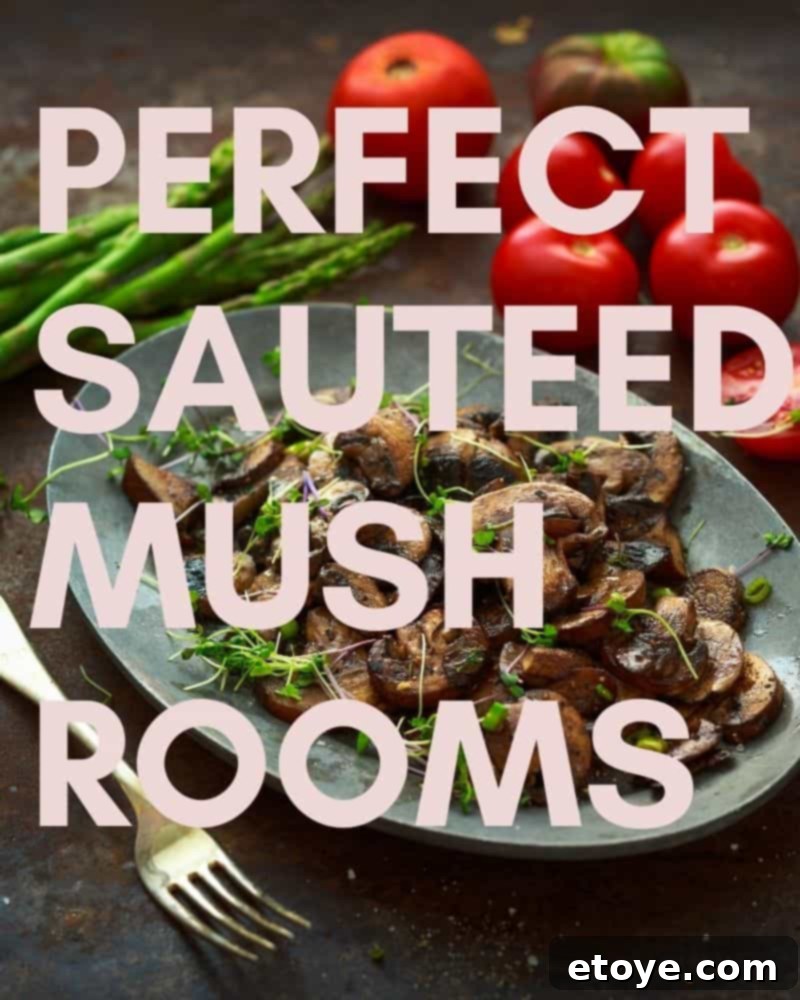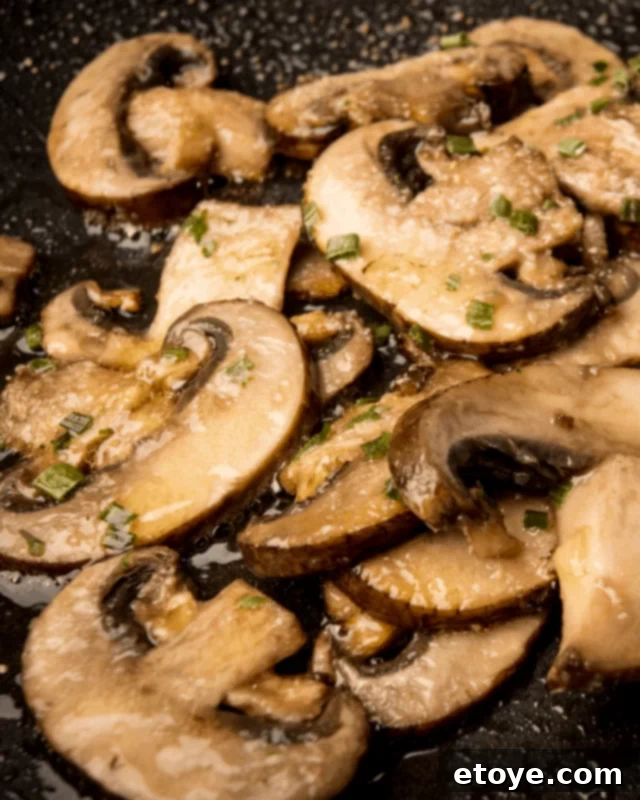Are you tired of serving soggy, bland, and unappetizing mushrooms that lack the beautiful golden-brown sear and tender texture you crave? Many home cooks encounter the common frustration of mushrooms releasing too much water during cooking, leading to a steamed rather than sautéed result. The good news is, the secret to transforming your mushrooms from watery and dull to perfectly caramelized, intensely flavorful, and deliciously browned is simpler than you might think. This comprehensive guide will unveil the essential techniques and insider tips to ensure your sautéed mushrooms are always a culinary triumph, ready to elevate any meal as a standalone side dish or a star ingredient in your favorite recipes.

The Common Culinary Conundrum: Understanding Soggy Mushrooms
Mushrooms are fascinating fungi, but their high water content often poses a challenge in the kitchen. Composed of approximately 90% water, they naturally release a significant amount of liquid when heated. The most prevalent mistake many cooks make is overcrowding the pan and adding fats or aromatics, such as garlic and onions, too early in the cooking process.
When you pack too many mushrooms into a pan, the moisture they release has nowhere to go. Instead of evaporating efficiently, it gets trapped, effectively steaming the mushrooms. This steaming prevents any proper browning or caramelization, resulting in a rubbery, watery texture and a lack of depth in flavor. This is precisely why your mushrooms might end up looking grey and unappetizing rather than golden and inviting.
Furthermore, traditional recipes often instruct home cooks to sauté aromatics like garlic, onions, or shallots before introducing the mushrooms. While this method is excellent for many other ingredients, it’s a recipe for disaster with mushrooms. The moisture from the mushrooms, combined with the fats and pre-cooked aromatics, creates an overly wet environment. This perpetuates the stewing effect, leaving you with mushrooms that are not only limp and unappetizing but also infuses the aromatics with excessive moisture, making them soggy and diluting their vibrant flavors. To truly unlock the potential of your fungi and achieve that desired perfectly browned finish, a strategic shift in your cooking approach is essential.
Versatile Delights: Sautéed Mushrooms for Buddha Bowls and Beyond

Perfectly sautéed mushrooms are incredibly versatile, making them an ideal and highly flavorful component for a wide array of dishes, especially wholesome Buddha Bowls. These vibrant, customizable bowls typically feature a base of grains, a protein source, a variety of fresh or cooked vegetables, and a delicious dressing. The earthy depth and satisfying texture of well-cooked mushrooms can elevate any Buddha Bowl, transforming it into a more substantial and gourmet meal.
Beyond their role in healthy bowls, these golden fungi can enhance a myriad of culinary creations. Imagine them as a sophisticated side dish accompanying grilled steaks, chicken, or fish, or as a hearty addition to fluffy omelets and savory frittatas. They make an exquisite topping for artisan pizzas, gourmet bruschetta, or crostini, adding an umami-rich layer of flavor. Fold them into creamy pasta sauces, stir them into risottos, or incorporate them into savory tarts for an extra dimension of taste and texture. Learning the easiest ways to cook, store, and utilize vegetables, particularly mushrooms, truly opens up a world of culinary possibilities, allowing you to create diverse and delicious meals with minimal effort.
Sautéed mushrooms pair wonderfully with a diverse range of herbs, from the woody fragrance of thyme and rosemary to the fresh, bright notes of parsley or chives. A simple squeeze of fresh lemon juice at the end can brighten their flavor profile, while a dash of soy sauce or balsamic vinegar can add a rich, complex, and savory finish. This straightforward technique ensures that your mushrooms are not just cooked, but truly shine as a flavorful, nutritious, and texturally appealing addition to any dish.
The Unveiled Secret to Perfect Sautéed Mushrooms: Timing is Everything
The true secret to achieving sautéed mushrooms with that coveted golden crust and a firm, tender interior lies in one critical adjustment to your cooking sequence: the precise timing of when you introduce fats and aromatics. Unlike many other sautéed ingredients, mushrooms demand a unique two-stage cooking process. They require an initial dry sauté to encourage them to release their considerable water content. Only *after* this moisture has completely evaporated should you introduce your butter, oil, garlic, shallots, or onions.
This sequential approach is pivotal. By allowing the mushrooms to shed their liquid first, you transform the cooking environment from a steamy one into an optimal dry surface. This dry heat is what enables the Maillard reaction—the chemical process responsible for the desirable browning, rich aromas, and deep, savory flavor that makes perfectly cooked mushrooms so irresistible. This crucial step prevents the infamous “soggy mushroom” dilemma, guaranteeing a delightful texture and concentrated flavor in every bite.
Once the pan is visually dry, the mushrooms have noticeably shrunk, and they’ve started to develop some initial color, that’s your definitive cue to proceed. At this point, you can confidently add the fat and aromatics. They will then beautifully infuse the already flavorful and perfectly textured mushrooms without becoming waterlogged themselves, resulting in a dish that is rich, aromatic, and texturally impeccable. This mastery of timing is the cornerstone of unlocking the full potential of this humble ingredient.
Four Essential Secrets for Mastering Sautéed Mushrooms
Achieving consistently browned and flavorful mushrooms requires more than just high heat and a pan. It comes down to understanding and implementing a few key techniques that address the unique characteristics of mushrooms. These four essential secrets will guide you through the process, ensuring every batch of sautéed mushrooms is a triumph, delivering maximum flavor and perfect texture.
Secret #1: Optimize Your Pan Choice and Space
The size and type of pan you use are paramount in preventing soggy mushrooms. Always opt for the largest skillet, sauté pan, or wok you have available. A spacious pan is not merely a suggestion; it’s a critical requirement because it provides ample surface area, allowing the mushrooms to spread out in a single layer without any overcrowding. When mushrooms are packed too tightly, they release their inherent moisture, and without sufficient space for this moisture to escape and evaporate, it creates steam. This steams the mushrooms rather than sautéing them, making it impossible to achieve that desirable browning.
Ensuring adequate space means the steam can efficiently escape, and the mushrooms come into direct and consistent contact with the hot surface of the pan. This direct contact is vital for facilitating the Maillard reaction, which is the key to creating that irresistible browned crust and developing profound, savory flavors. Think of it as giving your mushrooms the necessary room to breathe, crisp up, and caramelize, rather than suffocating them in their own steam. If you don’t have a pan large enough to accommodate all your mushrooms in a single layer, it is always advisable to cook them in smaller batches. While it may require a little more time, this patience pays off significantly in superior texture, concentrated flavor, and overall culinary satisfaction.
Secret #2: Embrace the Power of High Heat
High heat is your unwavering ally during the initial stage of sautéing mushrooms. This intense heat serves two crucial purposes: first, it rapidly brings the mushrooms up to temperature, effectively shocking them into quickly releasing their internal moisture. Second, and perhaps even more importantly, it efficiently evaporates that released water. The primary objective at this stage is to remove the water from the pan as quickly as possible, thereby transforming the cooking environment from a steamy, moisture-laden one into a dry, scorching hot surface that is perfectly conducive to browning.
Begin by preheating your largest pan over high heat until it is visibly hot, almost smoking. Then, add the damp mushrooms. It’s crucial to resist the urge to stir them constantly during the first few minutes. Allow them to sit undisturbed to establish firm contact with the hot surface of the pan. You will soon observe significant steam rising, a clear indication that the water is actively evaporating. As the water dissipates, the mushrooms will begin to sizzle, shrink slightly, and gradually take on a beautiful golden hue. Only once most of the liquid has visibly disappeared and the mushrooms have started to brown should you consider adjusting the heat or moving them around. Sustaining high heat throughout this initial phase is the indispensable key to preventing the dreaded watery outcome and unlocking truly delicious, perfectly sautéed mushrooms.
Secret #3: Master the Art of Timely Aromatic and Fat Introduction
This step is arguably the most critical “secret” in achieving truly perfect sautéed mushrooms. The golden rule is absolute: delay the addition of butter (or any cooking oil) and aromatics until *after* the mushrooms have completely released their water and the pan is relatively dry. Look for clear visual cues: the mushrooms will have visibly shrunk, the pan will no longer be watery or excessively steamy, and you might even hear a distinct, satisfying sizzling sound as they transition from steaming to browning. At this pivotal moment, if there’s any stubborn residual liquid, you can optionally spoon it out or gently blot with a paper towel, though vigorous high-heat cooking usually takes care of it effectively.
Once the mushrooms are dry and beginning to develop their desired golden-brown color, gently push them to the sides of the pan, creating a clear space in the center. Reduce the heat slightly to medium. Into this empty space, add your fat—whether it’s rich butter for a classic flavor or a neutral olive oil for a lighter touch. Allow the fat to melt and gently foam (if using butter) for a few seconds. Then, introduce your chosen aromatics: finely minced garlic, thinly sliced shallots, or finely diced onions. Sauté these aromatics for just 30-60 seconds, stirring constantly, until they become wonderfully fragrant but carefully avoiding any burning. This brief sauté allows the aromatics to release their full flavor into the fat before being fully incorporated with the mushrooms. Finally, mix the beautifully browned mushrooms with the fragrant aromatics and continue cooking for another 2-3 minutes, stirring occasionally, to allow all the incredible flavors to meld seamlessly. This precise timing ensures that both your aromatics and mushrooms are cooked to perfection, avoiding any sogginess and maximizing the depth of flavor.
Secret #4: Elevate Flavor with Thoughtful Finishing Touches
While the perfect sautéing technique lays an impeccable foundation, the final finishing touches can truly elevate your mushrooms from good to gourmet. A splash of soy sauce, for instance, is a fantastic way to introduce a profound depth of umami and a wonderfully savory finish. Its inherent saltiness also acts as a flavor enhancer, bringing out the natural deliciousness of the mushrooms. However, your options are far from limited to just soy sauce.
Consider a squeeze of fresh lemon juice, which offers a bright, acidic counterpoint. This acidity can cut through any richness, making the flavors pop and leaving a refreshing impression on the palate. Freshly chopped herbs, such as vibrant parsley, delicate chives, fragrant thyme, or earthy rosemary, stirred in during the final minute of cooking, infuse a wonderful freshness and aromatic complexity. For a different profile, a drizzle of balsamic glaze can add a sweet and tangy note, while a dash of dry sherry or white wine can introduce an extra layer of sophisticated flavor. For a touch of creamy indulgence, a tablespoon of heavy cream or crème fraîche can be stirred in at the very end.
Crucially, always remember to season your mushrooms with salt and freshly ground black pepper towards the end of the cooking process. Adding salt too early can draw out moisture prematurely, which could hinder proper browning. By seasoning at the end, you ensure optimal flavor development without compromising the perfect texture you’ve worked hard to achieve. Experiment with different combinations of these finishing touches to discover your favorite way to personalize your perfectly sautéed mushrooms and impress your taste buds.

Perfect Sautéed Mushrooms Recipe
The ultimate guide to cooking mushrooms in a skillet or sauté pan, yielding golden-brown, flavorful fungi that are never water-logged. An ideal addition to any Buddha Bowl or as a versatile side dish. Cooked with aromatic herbs, garlic, and shallots for an exquisite taste.
Recipe Details
- Prep Time: 5 minutes
- Cook Time: 15 minutes
- Course: Appetizer, Side Dish
- Cuisine: American
- Servings: 4
- Calories: 89 kcal
Ingredients
- 16 ounces fresh mushrooms (e.g., cremini, button, shiitake), sliced
- 1 teaspoon cooking oil (e.g., olive oil, grapeseed oil)
- 2 tablespoons unsalted butter
- 2 tablespoons minced shallot or onion
- 1 clove garlic, finely minced
- 2 tablespoons minced fresh herbs (e.g., parsley, thyme, chives)
- Salt and freshly ground black pepper, to taste
- Optional: A splash of soy sauce or a squeeze of lemon juice for finishing
Instructions
- Prepare Mushrooms: Slice the mushrooms evenly. Give them a quick rinse under cold water to clean them, but do not aggressively dry them. A little clinging water is fine for the initial cooking stage, as it will quickly evaporate.
- Preheat Pan & Initial Sauté: Heat the largest skillet, sauté pan, or wok you have over high heat until very hot. Add the damp mushrooms in a single layer (cook in batches if necessary to avoid overcrowding, as this is crucial for browning). Cook for about 5 minutes, initially undisturbed, until the mushrooms start sizzling, visibly releasing their water, and the liquid begins to evaporate.
- Add Oil & Continue Browning: Once most of the water has evaporated and the pan is mostly dry, add the cooking oil. Continue to cook and stir the mushrooms for another 3 minutes, allowing them to brown beautifully and develop a rich, golden color.
- Introduce Aromatics & Butter: Push the browned mushrooms to the sides of the pan, creating a clear space in the middle. Reduce the heat to medium. Add the butter to the empty space, allowing it to melt. Then, add the minced shallots (or onion), garlic, and fresh herbs to the melted butter. Sauté for about 30 seconds, stirring constantly, until they become wonderfully fragrant but without burning.
- Combine & Finish: Mix the fragrant aromatics and butter thoroughly into the mushrooms. Cook for another 3 minutes, stirring occasionally, allowing all the incredible flavors to meld together perfectly. Season generously with salt and freshly ground black pepper to taste. For an extra layer of flavor and brightness, add a splash of soy sauce or a squeeze of fresh lemon juice at this final stage.
- Serve: Serve your perfect sautéed mushrooms immediately as a delightful side dish, an integral part of your Buddha Bowls, or as a flavorful addition to your favorite meals.
Nutrition Information (per serving)
- Calories: 89 kcal
- Carbohydrates: 5g
- Protein: 4g
- Fat: 7g
- Saturated Fat: 4g
- Cholesterol: 15mg
- Sodium: 56mg
- Potassium: 377mg
- Fiber: 1g
- Sugar: 3g
- Vitamin A: 175 IU
- Vitamin C: 3mg
- Calcium: 3mg
- Iron: 1mg
Keywords
buddha bowl, buddhabowl, mushrooms, sautéed mushrooms, perfect mushrooms, never soggy, vegetable recipe, easy recipe, healthy recipe, side dish, golden mushrooms
By diligently following these straightforward yet impactful techniques, you can confidently transform your mushroom cooking experience. Bid farewell to soggy, lackluster fungi and welcome perfectly golden, intensely flavorful sautéed mushrooms to your plate every single time. We enthusiastically encourage you to try this game-changing method in your own kitchen and discover the true culinary potential of this humble yet magnificent ingredient. We’d be absolutely thrilled to hear about your experience! If you’ve tried this recipe or adapted it in your own creative way, please take a moment to share your thoughts, tips, and amazing results in the comments section below. Happy cooking!
